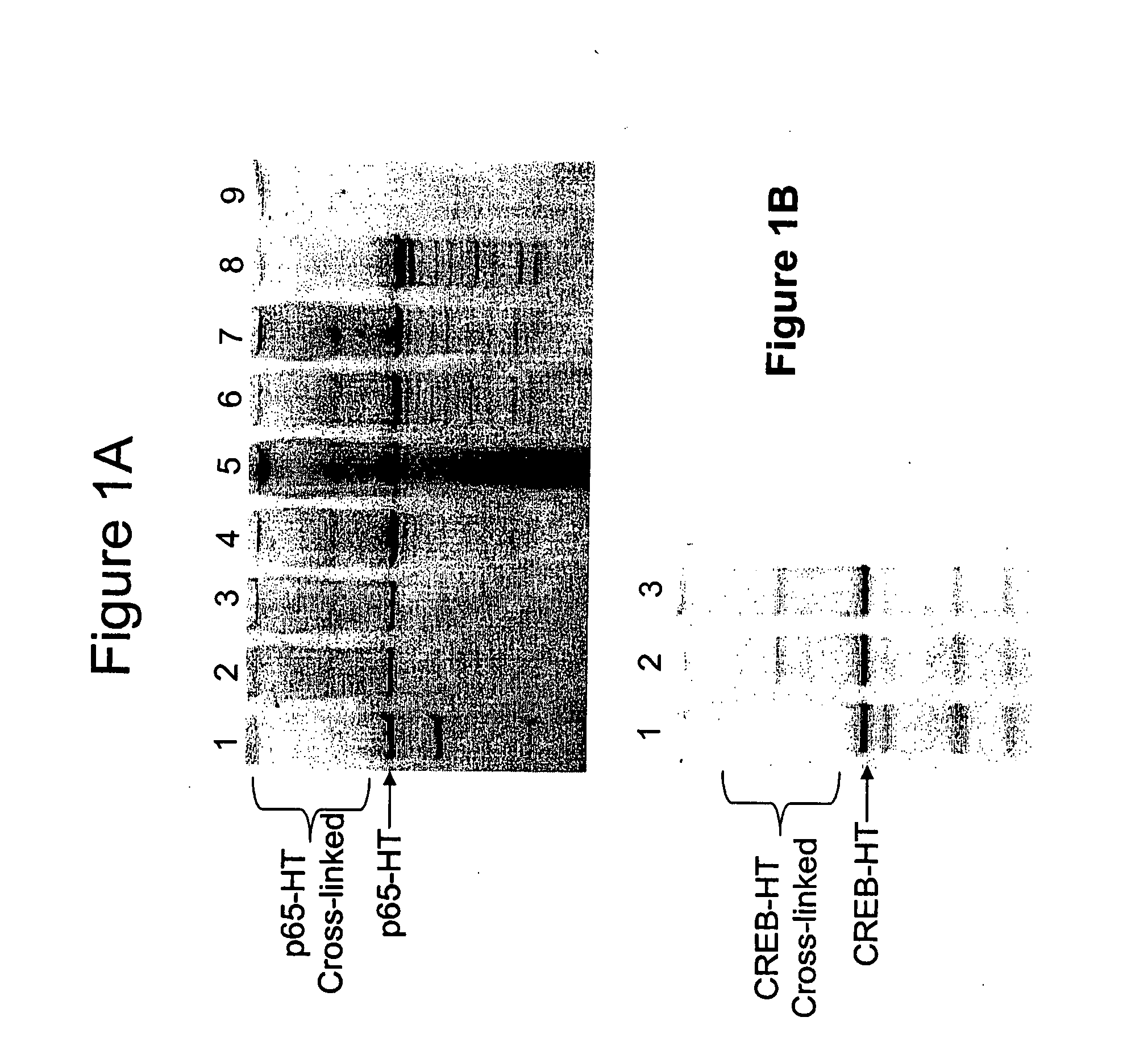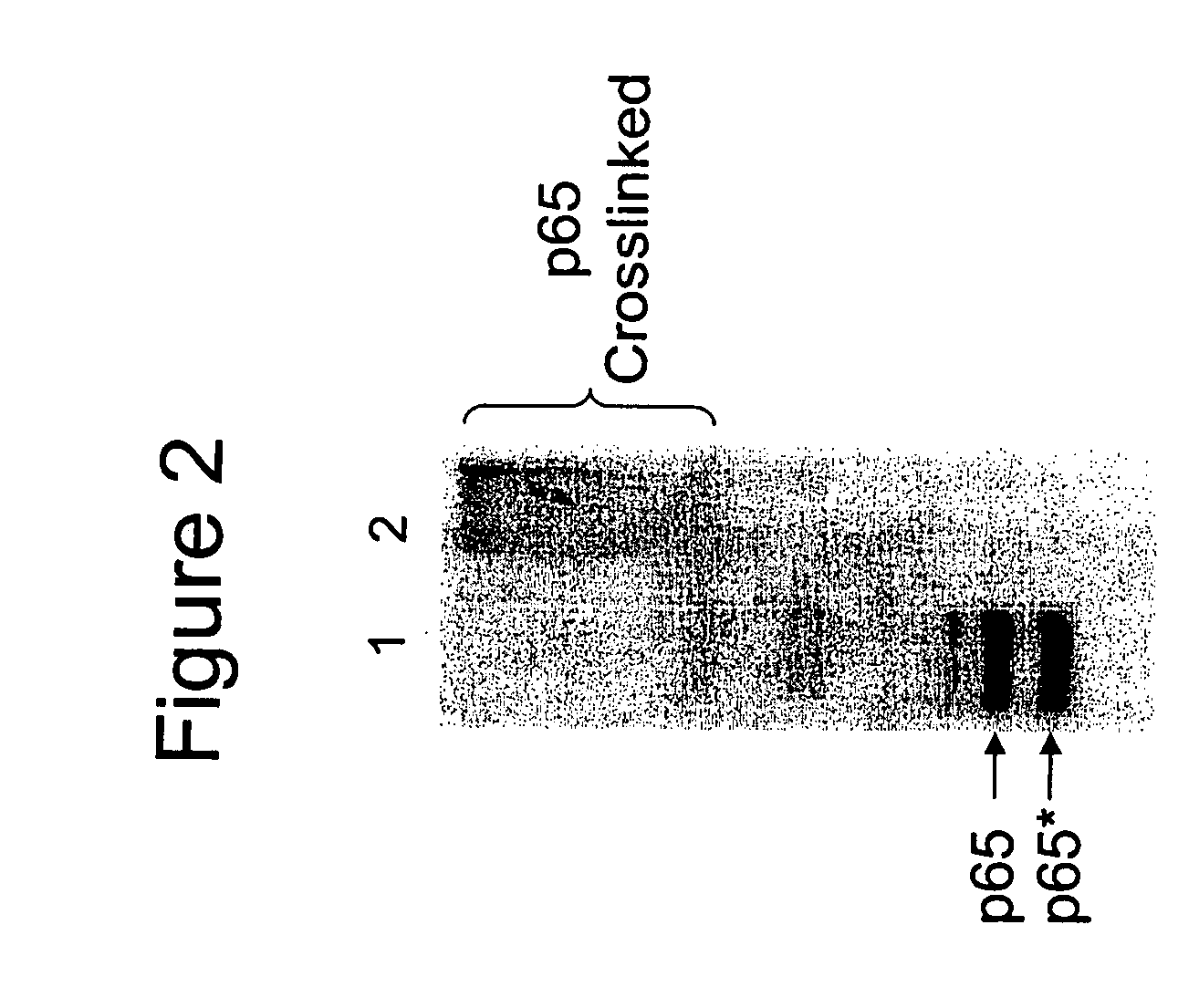Compositions and methods for capturing and analyzing cross-linked biomolecules
a biomolecule and composition technology, applied in the field of compositions and methods for capturing and analyzing cross-linked biomolecules, can solve the problems of difficult capture of biomolecules during interaction, insufficient to understand the function of each of these proteins in isolation, and methods that do not provide efficient capture of these complexes, etc., to achieve effective, selective and robust capture of cross-linked proteins
- Summary
- Abstract
- Description
- Claims
- Application Information
AI Technical Summary
Benefits of technology
Problems solved by technology
Method used
Image
Examples
example 1
Covalent Capture of Crosslinked Bait:Prey Complexes
[0053] Fkbp and the Frb domain of Frap have been shown to form a complex in the presence of a small molecule, rapamycin1. The minimal domains of Fkbp and Frb needed for the interaction1 were expressed in vitro as HT and GST fusion proteins in cell-free lysates as described. The Prey protein, GST-Frb, was fluorescently labeled using Fluorotect for detection and mixed with the Bait, Fkbp-HT, as described. The Bait:Prey mixture was then combined with HaloLink™ resin (as described above), which covalently binds HT, in the presence or absence of rapamycin (2 μM) and / or the thiol reversible protein:protein crosslinker, 5 mM DTTSP. Table 1 below represents the gel electrophoresis results showing the release of amounts of fluorescently labeled GST-Frb from the HaloLink™ resin under the test conditions. The lane labeled SM (Starting Material) represents the fluorescently labeled GST-Frb alone. GST-Frb was incubated with HT alone (Table 1, L...
example 2
Comparison of Crosslinking Bait:Prey Complexes Before or after Covalent Capture
[0054] The interaction between the transcription factors c-Jun and c-Fos is a well-characterized and is a high affinity interaction2. Similar to Example 1, binding experiments were performed using HaloLink™ Resin with c-Jun-HT as Bait and fluorescently labeled GST-cFos (Table 2a, SM) as Prey. Table 2A shows the gel electrophoresis results of the release of fluorescently labeled Prey from: HaloLink™ resin under the conditions described. Bait and Prey were treated in the following conditions: a. crosslinked with 5 mM DTTSP, then captured on HaloLink™, b. captured on HaloLink™, then crosslinked with 5 mM DTTSP, c. or captured on HaloLink™ with no crosslinker present (Table 2A, Lanes 1-3 respectively). The capture and release of prey occurs without the presence of crosslinker (Table 2A, Lane 3), while the detection of prey in the presence of DTTSP from the samples in Lanes 1 and 2 is observed only when cross...
example 3
Detection of In Vivo Crosslinked Protein:DNA Complexes
[0056] In order to determine whether or not in vivo crosslinked protein:DNA complexes would be able to covalently bind a ligand, i.e. the fluorescent TMR chloroalkane ligand (Promega Corp, Madison, Wis., Product #G8251), experiments were performed using two nuclear transcription factor proteins, p65 and CREB, expressed as HT fusion proteins. These proteins have been shown to bind to DNA at specific promoter regions and activate transcription in conjunction with a variety of other transcriptional proteins3. Both HT fusion proteins were transiently transfected into HeLa cells and treated with various concentrations of formaldehyde to induce protein:DNA crosslinks4 and subsequently lysed, either before or after labeling with the TMR ligand. The gel electrophoresis results for these experiments for p65-HT and CREB-HT are shown in FIGS. 1A and 1B, respectively. In FIG. 1A, lane 1 represents no formaldehyde added, lanes 2 and 4 repres...
PUM
| Property | Measurement | Unit |
|---|---|---|
| Covalent bond | aaaaa | aaaaa |
Abstract
Description
Claims
Application Information
 Login to View More
Login to View More - R&D
- Intellectual Property
- Life Sciences
- Materials
- Tech Scout
- Unparalleled Data Quality
- Higher Quality Content
- 60% Fewer Hallucinations
Browse by: Latest US Patents, China's latest patents, Technical Efficacy Thesaurus, Application Domain, Technology Topic, Popular Technical Reports.
© 2025 PatSnap. All rights reserved.Legal|Privacy policy|Modern Slavery Act Transparency Statement|Sitemap|About US| Contact US: help@patsnap.com



